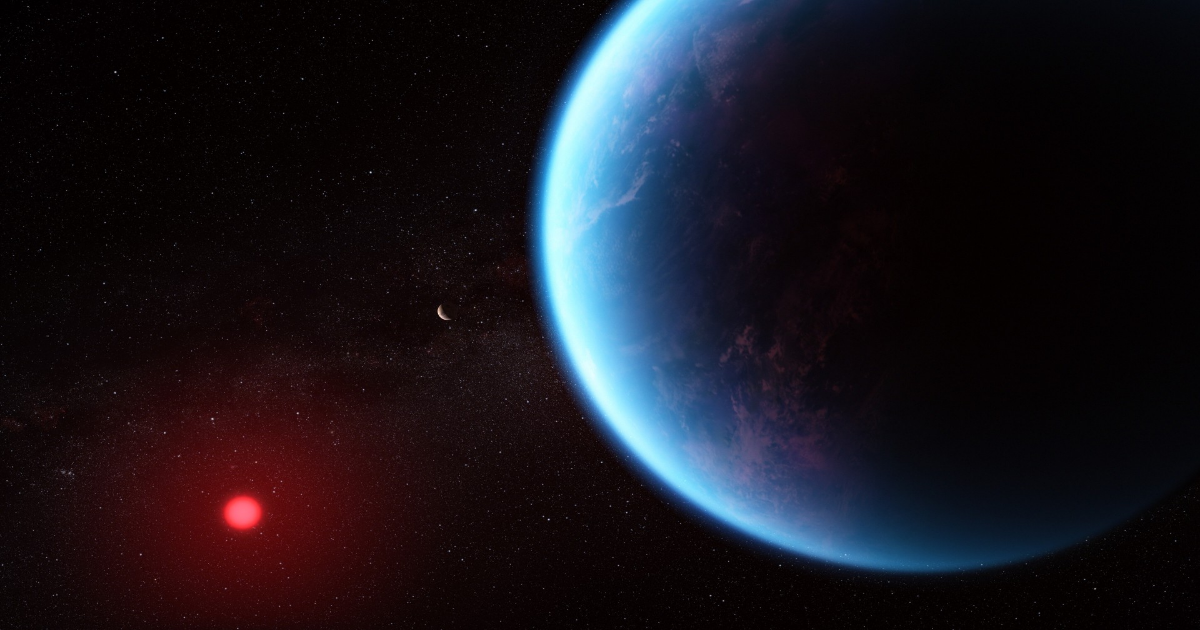Scientists have found further evidence of possible biosignature gases on the nearby exoplanet K2-18b, strengthening the case that it could support alien life.
In 2023, researchers using NASA’s James Webb Space Telescope (JWST) reported the potential presence of dimethyl sulfide (DMS) on K2-18b, which is nearly nine times more massive than Earth and circles in the “habitable zone” of a star about 120 light-years away from us.
Here on Earth, DMS is produced primarily by life — most prolifically by phytoplankton and other marine microbes — so the 2023 study was met with some enthusiasm. The excitement was tempered, however, by the preliminary nature of the find; JWST’s observations were consistent with the presence of DMS but did not confirm it. So the study team looked again, but in a slightly different way this time.
JWST can probe exoplanet atmospheres when these worlds “transit,” or cross the face of, their host stars from the observatory’s perspective: The telescope detects certain molecules in the air based on the wavelengths of starlight that they absorb.
You may like
Related: Does exoplanet K2-18b host alien life or not? Here’s why the debate continues
The team made the original, tentative DMS detection using JWST’s NIRISS (Near-Infrared Imager and Slitless Spectrograph) and NIRSpec (Near-Infrared Spectrograph) instruments. For the new study, the researchers employed the $10 billion telescope’s Mid-Infrared Instrument (MIRI), which scrutinizes different wavelengths of light.
MIRI also detected the fingerprint of DMS (and/or dimethyl disulfide, or DMDS, a close chemical cousin and also a potential biosignature), the researchers report in the new study, which was published online today (April 17) in The Astrophysical Journal Letters.
Breaking space news, the latest updates on rocket launches, skywatching events and more!
“This is an independent line of evidence, using a different instrument than we did before and a different wavelength range of light, where there is no overlap with the previous observations,” Nikku Madhusudhan, a professor at Cambridge University’s Institute of Astronomy, who led both K2-18b studies, said in a statement today. “The signal came through strong and clear.”
Based on its size and other characteristics, astronomers suspect that K2-18b may be a “Hycean” world — a class of exoplanet proposed in 2021 that has a huge liquid-water ocean and a hydrogen-rich atmosphere. (“Hycean” is a portmanteau of “hydrogen” and “ocean.”)
And K2-18b’s air is also rich in DMS and/or DMDS, according to the new study. The researchers estimate concentrations of more than 10 parts per million by volume, compared to less than one part per billion for them here on Earth.
“Earlier theoretical work had predicted that high levels of sulfur-based gases like DMS and DMDS are possible on Hycean worlds,” Madhusudhan said. “And now we’ve observed it, in line with what was predicted. Given everything we know about this planet, a Hycean world with an ocean that is teeming with life is the scenario that best fits the data we have.”
Madhusudhan and his team aren’t claiming to have detected alien life; they say that more research is needed to confirm and extend their findings. Other scientists feel the same way — and some are injecting heavier doses of skepticism into the debate around K2-18b and its life-hosting potential.
One of them is astronomer Chris Lintott, who took issue with Madhusudhan’s “strong and clear” characterization of the DMS/DMDS signal.
“Meanwhile, the peer-reviewed paper says ‘While [the presence of molecules] DMDS and DMS best explains the current observations, their combined significance … is at the lower end of robustness required for scientific evidence,” Lintott, an astrophysics professor at the University of Oxford, wrote on the social media site BlueSky yesterday (April 16).
Detecting signs of alien life is a tricky business, and confirming them is even tougher — especially on a world like K2-18b, which we won’t be able to investigate up close for the foreseeable future, if ever. So we should expect the debate, and the data collection, to continue.
